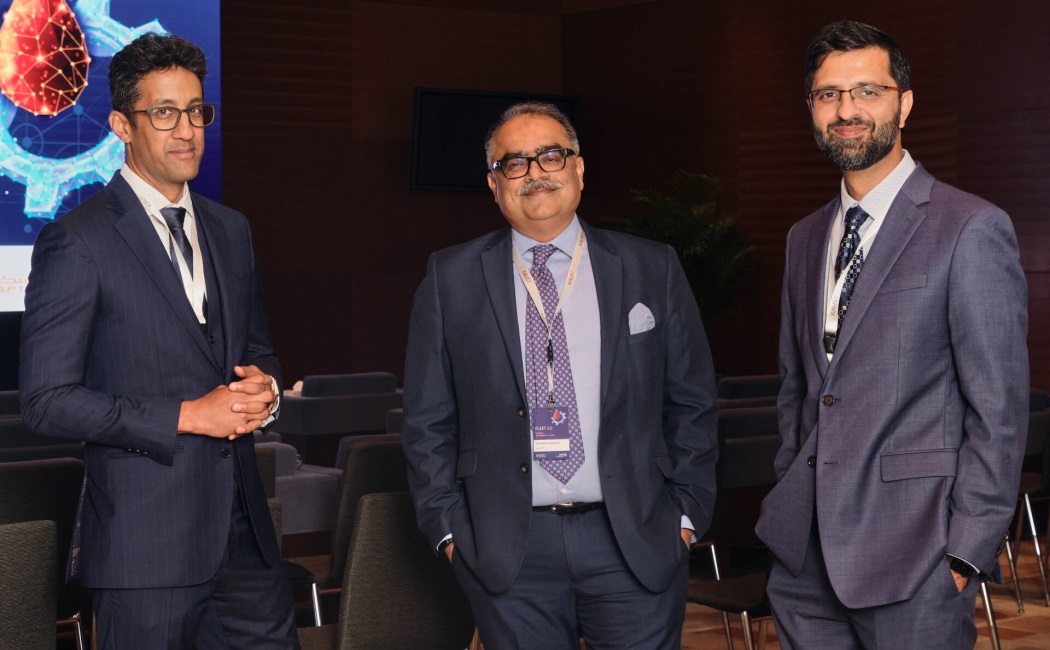

.png?sfvrsn=1b6bae1a_0) (FASTER)
(FASTER).png?sfvrsn=ac211bda_0)

16 October, 2023
Existing petrochemical refinery infrastructure could be repurposed to manufacture clean e-fuels derived from hydrogen and captured carbon dioxide. The finding is one outcome from a suite of projects undertaken by the FLEET consortium, a multi-partner collaborative research program initiated by KAUST and the Oil Sustainability Program of the Ministry of Energy of Saudi Arabia to reduce the transportation sector’s carbon footprint.
“Industrial partnerships are a proven route for translating academic research into real-world applications,” says KAUST mechanical engineering Aamir Farooq. But some societal challenges are so great that something bigger than a one-to-one collaboration is required.
“The problem of CO2 emissions from transportation, and the overall sustainability of the transport system, is such a broad challenge that it requires a big team effort to tackle it,” Farooq says. “We envisioned the FLEET consortium to bring together multiple stakeholders and companies to work on topics of common interest for this pressing global problem.”
Industry buy-in for the concept has been strong, with Toyota, Hyundai Motor Group and Saudi Aramco among the six companies joining the FLEET consortium for its 2022 inaugural year. Two more companies, Ferrari and Luberef, have joined for 2023. “The first year of FLEET exceeded our expectations and we hope for even greater things in the second year,” Farooq says.
The FLEET project was initiated in 2021, when Farooq and KAUST chemical engineer Mani Sarathy proposed the “big team” concept to contacts within the Oil Sustainability Program of the Ministry of Energy. “The Ministry folks helped us get in touch with various companies, and most companies we reached out to were thrilled by the idea,” Farooq says.
Each FLEET project is selected and undertaken in close collaboration with member companies. “An important aspect of the FLEET framework was that the work should not only stay at the university, but should be transferred to the company sites for further testing and prototyping to reach a higher level of technology readiness,” Farooq says.
One topic that sparked significant interest was e-fuels. “During the first year, four companies — Hyundai, Toyota, Aramco and the Saudi Public Transport Company SAPTCO — showed really strong interest in this important topic,” Farooq says. The group identified a need for two separate e-fuel projects to be launched.
One, led by Sarathy, explored the practicalities of industrial scale methanol-to-gasoline production. Methanol-to-gasoline is a catalytic process that can produce e-gasoline from green methanol made from captured CO2. “We wanted to investigate whether we could repurpose refinery equipment for methanol-to-gasoline to reduce the capital and operational cost of the process and make it more feasible for industry,” says Carolina Arias Gallego, a Ph.D. student in Sarathy’s group.
The team showed that a reactor called a catalytic reformer could be repurposed for methanol-to-gasoline production and calculated that the gasoline price would increase by around US$1/kg when produced by this method. “Considering the minimal price increase and the ability to repurpose existing equipment, the overall cost for industrial application is relatively low,” Arias Gallego says.
A second e-fuels project, led by Farooq, examined e-gasoline utilization. “We’ve heard a lot about different e-fuels, but there hadn’t been a systematic study of the use of these fuels for transportation, from fundamental research to testing in engines,” he says.
Due to their different origins and modes of manufacture, e-gasoline and conventional gasoline have key chemical differences affecting their combustion performance. The KAUST team showed e-gasoline’s ignition behavior was faster than what is needed in high-efficiency engines but could be modified by blending it with additives ranging from green methanol to conventional gasoline. “The idea to blend e-gasoline with conventional gasoline came from the participating car companies,” Farooq says. “They suggested that in the near future we will not have enough e-gasoline to use it alone, so there could be a scenario where you blend e-gasoline with conventional gasoline.”
Fuel blend samples were sent to Saudi Aramco to run in their test engine, and the next step will be to run them in a real car. “Hyundai has offered to provide the car for vehicle testing,” Farooq says.
Other projects conducted during the first year of research included supercritical fuel combustion and waste-heat capture of marine engines for more efficient shipping and the exploration of hydrogen-driven fuel cells for zero-emission vehicles.
The FLEET consortium’s big team model has been even more successful than initially hoped, Farooq says. “I especially enjoy the monthly progress meetings,” he says. “Our industrial partners have been very engaged, giving feedback and always looking at ways to take the work forward. FLEET’s multipartner consortium model has gained a lot of interest in Saudi Arabia,” Farooq notes, and it is being explored for other areas of research, from low-carbon cement production, to composite materials development. “The model works very well and I think we will see it being applied to other grand challenges,” Farooq says.
KAUST INSIGHT